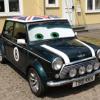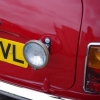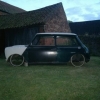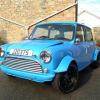There are a few rules in relation to the car for the place we race...
CONSTRUCTIONS REGULATIONS
1. All vehicles must have an UNMODIFIED standard original body shell of the closed car type (no open specials, commercial vehicles or sports cars with soft tops etc). All body panels must be retained i.e. boot lid, bonnets, doors, wings and bumpers. Glass sunroof panels must be removed and the hole must be covered with a plate at least the same thickness as the body shell.
2. Engine and body shell must be related. Conglomerated vehicles that consist of components from different makes/models are prohibited. Authoritative documents can be consulted if eligibility is in doubt (Mk 1 cars must only have Mk 1 engine fitted).
3. Bodies can be strengthened in any way, as long as the strengthening does not protrude outside the body shell. 41. Only two wheel drive vehicles are eligible. 42. Tow bars must be removed to the point where they no longer protrude past the rear bumper.
4. Wheels can be wider than those normally fitted. Tyres must be serviceable with no cuts or bulges and tread is to be evident and of normal road or winter type. Spacers are also prohibited.
5. No racing / slick or sand tyres are allowed. Tyres fitted to vehicles must have been readily available from retailers and initially designed for use on public roads.
6. ENGINES MUST NOT BE MODIFIED IN ANY WAY Cylinder heads, manifolds and carburettors must remain as standard. Vehicles found to have engine modifications will be disqualified from that race meeting.
7. GEARBOXES only stock gearboxes of the type originally fitted to the car are to be used. The fitting of race gearboxes or up rated gearboxes onto cars is forbidden and will result in disqualification. (This amendment was agreed at the 2007 AGM).
8. Racing numbers must be displayed upright on the roof of the car. The number must be clearly legible on both sides of the vehicle. Numbers must be a minimum size of 15 cm, and plates should be mounted to the rear of the roof.
9. Cars must be presented in a smart and professional manner. Team colours are encouraged and any sign writing on the car is to be as neat as possible. Cars must be cleaned prior to each race meeting. Cars are not to be raced with abusive slogans or language decorating them.
10. All interior lights / glass (apart from the windscreen) and interior trim must be removed. The dashboard may be retained. The driver's seat is to be fully secured to either standard or reinforced fittings.
11. Driver’s side window protection must be fitted; it must be easily removed, in the case of an accident from the outside of the vehicle. Window protection is to be of Perspex, grill or netting.
12. A FULL roll-cage must be fitted to the vehicle and be of a rigid construction. It must be made from material with sufficient strength to withstand impact in the event of a roll over. It must be a minimum of 4 cm tubing or 4 cm x 4-cm box section in diameter. Motorway barrier / staging and light alloy tubing is forbidden. The main loop must be positioned as close to the rear of the driver’s seat as possible, and have no bolted joints, i.e. three welded sections or one solid form to shape the section. The main loop must be of sufficient width to give adequate protection over the width of the Car. The two struts facing rearward from the verticals of the main loop must be bolted to the main body of the car. If the struts are bolted to the main loop, it must be to lugs of sufficient strength or using special type tube fittings as used on FIA approved roll-cages. The roll- cage securing bolts must be of a minimum of 10 mm thread diameter. A driver's side door bar must be fitted to the main roll-cage in the same manner as the rear struts but must use spreader plates where fitted to any part of the bodywork. The tube must be a minimum of 4 cm in diameter. The bar must be fitted along the outside of the roll-cage. Spreader plates must be fitted to both sides of the vehicle skin where any Part of the roll-cage is joined to the body shell. All struts that are forward of the main loop must not restrict movement of the drivers head. Any section that comes in contact with the driver's body is to be padded. Any section of the body shell on to which the cage is bolted must be of sufficient strength to withstand impact in the event of a rollover. (Advice on roll-cage construction can be sought from the chief scrutineer).
13. Driver's face protection is mandatory. The front windscreen may be of laminated glass or Perspex. If using Perspex, it is to be at least 4mm in thickness. When using a laminated windscreen, no cracks are to be visible within the drivers third of vision. The driver's vision must be clear. The original glass in the side windows and rear must be removed. The car must be fitted with a serviceable wash/wipe system when glass or Perspex is fitted in the front screen area. Alternatively, a wire mesh with a matrix no bigger than l2 mm may be fitted; this mesh must fill the entire window aperture and be of sufficient strength. This must be held in place by a minimum of two metal jubilee clips each side and one top and bottom in the centre of the screen. Whether the vehicle is fitted with glass, Perspex or mesh, helmets with visors or goggles must be worn at all times during racing. If glass is replaced at any time during a race meeting, the vehicle is to be re-scrutinised.
14. A full harness seatbelt must be fitted, i.e. two shoulder and lap restraints. Normal car inertia belts are prohibited. All belts must be of a named type and are not to be modified in any way (no homemade harnesses). Harnesses must be attached directly to bolts / eye bolts mounted to a secure area of the body shell at either side of and behind the driver (i.e.: minimum of three securing points).
15. Both front doors must be left operational. Rear doors must be positively secured by either bolting or welding. Boots and bonnets must have anti-burst devices fitted, however bonnets that hinge from the front are excused.
16. Brakes and steering must be fully serviceable (this includes the handbrake). Any vehicle that uses any type of ballast must make sure it is fully secured. Body panels must be secure and no sharp edges or protrusions are allowed.
17. The exhaust system must exit the engine compartment and have at least one silencer fitted. If the exhaust enters the driver’s compartment, it must be shielded to prevent accidental Contact. Noise from the exhaust must not exceed 98Db @ 1 meter from the end of the exhaust pipe.
18. Batteries must be secured by two positive methods. If fitted in the driver's compartment, they must be sealed in a leak proof compartment, and must be insulated with a non-conductive material.
19. Original petrol tanks may be used with a serviceable fuel gauge. A smaller tank (max 10 litres) may be used but must be fitted in a secure and positive manner in the rear of the car in a non-Contact area. The tank must be fitted with a breather that must exist outside the car. Tin gauge tanks are prohibited. A metal splashguard must be fitted between any internal tank and the driver. The splashguard must cover the complete width of the vehicle and be a minimum of 30cm in height above the top of the fuel tank or completely enclose the fuel tank. Fuel pipes inside the vehicle must be secured and protected from chaffing on any part of the bodywork.
20. Radiators may be fitted within the body shell. If fitted in the driver's compartment, a screen must protect the driver in case the radiator bursts or leaks in any way. Any pipes that run through the shell must be made of metal and painted RED. The pipes must also be shielded to prevent accidental contact.
21. The fitting of Fire Extinguishers is compulsory. They MUST be fitted within easy reach of the driver when racing and must be in a quick release holder and NOT taped in place.
22. 2 rear view mirrors of a size not less than 10x5cm must be fitted to the car. One mirror must be an interior rear view mirror.
23. A method of attaching a recovery rope must be fitted. Front and rear pillars are acceptable, but vehicles fitted with full width screens must fit a hook of some description. All tow points must be marked clearly.
24. Ignition switches may be retained, an engine cut out switch must be fitted and the ON/OFF positions clearly marked on the external area of the car and easily accessible by the Marshall's.
25. Electric fuel pumps must be isolated through the ignition switch or engine cut out switch. A master switch may be fitted and is to isolate all electric’s, its location is to be clearly marked on the vehicle.
26. A mandatory brake light integrated in the conventional rear light cluster or in the rear window aperture is to be fitted. The vehicle must also have a bad weather light fitted. Both lights are to be RED. The Clerk of the course will decide if the bad weather light should be switched on.
27. Any doubt concerning the construction regulations is to be forwarded in writing to the OIC Gütersloh Rally-Cross Club for the correct interpretation of the rules. If there is doubt over the rules during a race meeting, then the decision of the Chief Scrutineer is final.
28. If a car is suspected of having a modified engine or gearbox, then the vehicle will be taken to an approved garage and tested for BHP on a rolling road. This will be done at the expense of the club if the suspected offender is innocent. If however the results are positive the expense will be down to the club member. If the club member refuses to have the vehicle tested then he will be banned from any future meetings.

























